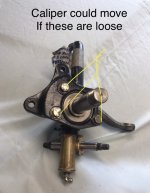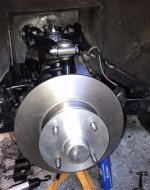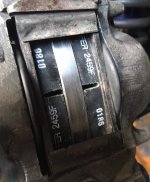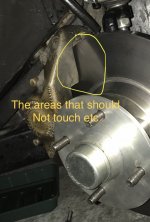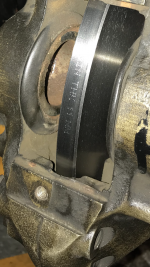Was there a set number of spacers to the left and right of the rotor(disc) when TR3's left the factory or did centring the disc vary from vehicle to vehicle? I've bought new discs for my car and was wondering if this is a trial and error thing? I read on the forum where dental floss comes in handy to hold the spacers in place during the mounting process.
-
 Hi Guest!
Hi Guest!
If you appreciate British Car Forum and our 25 years of supporting British car enthusiasts with technical and anicdotal information, collected from our thousands of great members, please support us with a low-cost subscription. You can become a supporting member for less than the dues of most car clubs.
There are some perks with a member upgrade!**Upgrade Now**
(PS: Subscribers don't see this gawd-aweful banner

Tips
- We have a special forum called "Member Articles" where you can submit actual articles for consideration for publication. Learn More
- Don't have an Avatar? If not, your avatar will default to the 1st character in your username. Go into "Account Details" to change your Avatar.
- Some basic forum navigation info: click
Hey - did you know if you click on the title of a thread it will take you to the first unread post since you last visited that thread?
- Hey Guest - Is your British Car Club in our Clubs database? If not, send me a PM - Basil

- Looking for a local club? Click the "Clubs" tab above and browse hundreds of clubs world-wide.
- Add Android or iPhone APP: click
- Did you know - any picture or video you add in your posts in any marque-specific forum will also get added to the Media Gallery automatically.
- A few more tips about posting and replying: click
- Hey there Guest - be sure to keep your profile page up to date with interesting info about yourself: learn more
- More tips and tricks on Posting and Replying: click
 STOP!! Never post your email address in open forums. Bots can "harvest" your email! If you must share your email use a Private Message or use the
STOP!! Never post your email address in open forums. Bots can "harvest" your email! If you must share your email use a Private Message or use the  smilie in place of the real @
smilie in place of the real @
- Want to mention another member in a post & get their attention? WATCH THIS

- So, you created a "Group" here at BCF and would like to invite other members to join? Watch this!
- Hey Guest - A post a day keeps Basil from visiting you in the small hours and putting a bat up your nightdress!
- Hey Guest - do you know of an upcoming British car event?
 Pretty Please - add it to our Events forum(s) and add to the calendar! >> Here's How <<
Pretty Please - add it to our Events forum(s) and add to the calendar! >> Here's How << 
- Hey Guest - you be stylin'
Change the look and feel of the forum to fit your taste. Check it out
- If you run across an inappropriate post, for example a post that breaks our rules or looks like it might be spam, you can report the post to the moderators: Learn More
- If you would like to try some different "looks" or styles for the site, scroll to the very bottom, on the left and click the Style Selector.
You are using an out of date browser. It may not display this or other websites correctly.
You should upgrade or use an alternative browser.
You should upgrade or use an alternative browser.
TR2/3/3A Spacers to centre the the front brake rotor?
- Thread starter karls59tr
- Start date
I just did mine by trial and error. I've read in other threads that the presence or absence of spacers really doesn't make much if any difference.
Edit: I'm referring to the "dogbone" shaped spacers that go on the caliper bracket -- they actually center the caliper rather than the rotor. Is that what you're asking about?
Edit: I'm referring to the "dogbone" shaped spacers that go on the caliper bracket -- they actually center the caliper rather than the rotor. Is that what you're asking about?
Yes I meant the dogbone shaped spacers that center the caliper.I just did mine by trial and error. I've read in other threads that the presence or absence of spacers really doesn't make much if any difference.
Edit: I'm referring to the "dogbone" shaped spacers that go on the caliper bracket -- they actually center the caliper rather than the rotor. Is that what you're asking about?
Yes I meant the dogbone shaped spacers that center the caliper.
Offline
Mine broke when refurbing the brakes so left them out and it made no difference.
the pistons effectively self centre the pads on the disc.
If the caliper is way off Center to the disc there is something wrong. Typically the disc/hub/bearing issue.
the pistons effectively self centre the pads on the disc.
If the caliper is way off Center to the disc there is something wrong. Typically the disc/hub/bearing issue.
Could you elaborate on the disc/hub/ bearing issue or send a link to the issue. I had an incident last year where I was on the highway at high speed and the left front brake locked up. I managed to steer the car over to the side of the road. Got out to find the left wheel tilted about 25degrees over the caliper. The brakes had become so hot that there were grease fires above the calipers. I put out the flames with gravel and called a tow truck. Quite an adrenaline rush fighting the steering wheel. I'm not sure what caused the brakes to lock up on that one side but I believe either the caliper piston had stuck on or something in the disc/hub caused the issue? ie caliper not centered or wrong assembly of hub bearing. I am in the process of rebuilding the brake slave and master cylinders and have replaced all the damaged components. Getting ready to install the calipers and disc rotors. Any thoughts?Mine broke when refurbing the brakes so left them out and it made no difference.
the pistons effectively self centre the pads on the disc.
If the caliper is way off Center to the disc there is something wrong. Typically the disc/hub/bearing issue.
Offline
Hi Karl
i will try. i'm not the best typist so forgive the short points - its just quicker
the caliper is a fixed(point)item to the upright and can't move.
the disc fits in the caliper aperture and there are tolerances and typically there will be sufficient space between rotor/disc and caliper.
if the caliper is touching the dic there is something fundamentally wrong.[
the pads will self centre /adjust with use. we can see this with the caliper pistons clamping the pads.
this will also happen if one caliper piston is seized the other will carry on the pressure and wear out.
but if the error is in the hub or disc (rotor) a poorly seated hub ( as in my case when fitting ali hubs and uprated stub axle) the disc can run out of true/alignment.
this is what happens when bearings break down ( as look like yours did) ) outside bearing ?? looks to have failed and got hot.
extreme cases see the disc / wheel wobble, lock up or fall off.
this is because the stub axle is also fixed to the same upright as the caliper so these are rigid to each other.
the hub spins, yes so not fixed but also has felt backing to the bearings, the bearings themselves, end float- where you do the stub axle nut up tight so the wheel doesn't spin then back it off a little so it does and that you can get the split or cotter pin in.
the simple test for bearings is to have the wheel off the ground and grab hold of the top and bottom of the wheel and try and rock it. if it does and you would feel/hear it you need to tighten it a little more. do this check regularly.
if you have to keep doing this and tightening, the bearings are on the way out.
hope the pics help
and i haven't insulted you intelligence as i am sure you know this already.
but as i say i fitted new hubs and ran into problems.
it was part of an upgrade on my 3a to 4a spec suspension so i have camber and castor now.
and i run the wheels parallel no toe in or out.
hope this helps ?
H
i will try. i'm not the best typist so forgive the short points - its just quicker
the caliper is a fixed(point)item to the upright and can't move.
the disc fits in the caliper aperture and there are tolerances and typically there will be sufficient space between rotor/disc and caliper.
if the caliper is touching the dic there is something fundamentally wrong.[
the pads will self centre /adjust with use. we can see this with the caliper pistons clamping the pads.
this will also happen if one caliper piston is seized the other will carry on the pressure and wear out.
but if the error is in the hub or disc (rotor) a poorly seated hub ( as in my case when fitting ali hubs and uprated stub axle) the disc can run out of true/alignment.
this is what happens when bearings break down ( as look like yours did) ) outside bearing ?? looks to have failed and got hot.
extreme cases see the disc / wheel wobble, lock up or fall off.
this is because the stub axle is also fixed to the same upright as the caliper so these are rigid to each other.
the hub spins, yes so not fixed but also has felt backing to the bearings, the bearings themselves, end float- where you do the stub axle nut up tight so the wheel doesn't spin then back it off a little so it does and that you can get the split or cotter pin in.
the simple test for bearings is to have the wheel off the ground and grab hold of the top and bottom of the wheel and try and rock it. if it does and you would feel/hear it you need to tighten it a little more. do this check regularly.
if you have to keep doing this and tightening, the bearings are on the way out.
hope the pics help
and i haven't insulted you intelligence as i am sure you know this already.
but as i say i fitted new hubs and ran into problems.
it was part of an upgrade on my 3a to 4a spec suspension so i have camber and castor now.
and i run the wheels parallel no toe in or out.
hope this helps ?
H
Attachments
Hello I believe the bearing may have failed because I did not set the end float correctly? If the stub axle nut was too tight that would have caused the failure ,correct? I have read on the forum that the felt backing that suppliers are sending is too thick and has to be cut down with a razor? Would installing a too thick felt backing cause the bearing to be improperly adjusted and cause bearing failure? I noticed in your first picture of the stub axle you pointed out 3 bolts that if loose could cause the caliper to move. That had not occured to me and i will definetly check those. Do you do a gradual brake in of the new pads?Hi Karl
i will try. i'm not the best typist so forgive the short points - its just quicker
the caliper is a fixed(point)item to the upright and can't move.
the disc fits in the caliper aperture and there are tolerances and typically there will be sufficient space between rotor/disc and caliper.
if the caliper is touching the dic there is something fundamentally wrong.[
the pads will self centre /adjust with use. we can see this with the caliper pistons clamping the pads.
this will also happen if one caliper piston is seized the other will carry on the pressure and wear out.
but if the error is in the hub or disc (rotor) a poorly seated hub ( as in my case when fitting ali hubs and uprated stub axle) the disc can run out of true/alignment.
this is what happens when bearings break down ( as look like yours did) ) outside bearing ?? looks to have failed and got hot.
extreme cases see the disc / wheel wobble, lock up or fall off.
this is because the stub axle is also fixed to the same upright as the caliper so these are rigid to each other.
the hub spins, yes so not fixed but also has felt backing to the bearings, the bearings themselves, end float- where you do the stub axle nut up tight so the wheel doesn't spin then back it off a little so it does and that you can get the split or cotter pin in.
the simple test for bearings is to have the wheel off the ground and grab hold of the top and bottom of the wheel and try and rock it. if it does and you would feel/hear it you need to tighten it a little more. do this check regularly.
if you have to keep doing this and tightening, the bearings are on the way out.
hope the pics help
and i haven't insulted you intelligence as i am sure you know this already.
but as i say i fitted new hubs and ran into problems.
it was part of an upgrade on my 3a to 4a spec suspension so i have camber and castor now.
and i run the wheels parallel no toe in or out.
hope this helps ?
H
one more thing. If the main seal in the brake MC is worn out could that cause a caliper piston to seize? Thanks for your input it has been most helpful.
K
Offline
There are 4 bolts on the caliper mount you just can’t see one in the pic. Many use a 2 bolt lock tab here I use a thread lock fluid.
pull on the caliper see if there is any movement if the hub etc is all together.
now have uprated hub don’t have the felt as they use sealed bearings. But I have heard new felts are too thick and are being cut down.
It may keep the inner bearing from fitting -? I don’t know for sure.
a too tight stub axle nut could cause over heating ! But when tightened the wheel should still spin by hand. And too tight it would be v stiff or locked on.
The bearings needs a good packing with grease - both inner and outer set.
I guess a worn MC could lock the brakes but all of them as it’s a common pressure point for all 4 wheels !!?? More likely to loose braking if MC seals poor.
I have had a front brake hose collapse inside and not let the pressure off and it cooked /blued a disc on my old Daimler sp250- very similar brakes. Looked fine from outside. This can create lots of heat thus melt the grease out of hub bearing.
Many what if I am afraid …
pull on the caliper see if there is any movement if the hub etc is all together.
now have uprated hub don’t have the felt as they use sealed bearings. But I have heard new felts are too thick and are being cut down.
It may keep the inner bearing from fitting -? I don’t know for sure.
a too tight stub axle nut could cause over heating ! But when tightened the wheel should still spin by hand. And too tight it would be v stiff or locked on.
The bearings needs a good packing with grease - both inner and outer set.
I guess a worn MC could lock the brakes but all of them as it’s a common pressure point for all 4 wheels !!?? More likely to loose braking if MC seals poor.
I have had a front brake hose collapse inside and not let the pressure off and it cooked /blued a disc on my old Daimler sp250- very similar brakes. Looked fine from outside. This can create lots of heat thus melt the grease out of hub bearing.
Many what if I am afraid …
There is an uprated stub axle kit that vastly improves the front wheel bearing setup. It's available from the big retailers, or for much less money from the family of the guy who came up with it here.
In addition to a stronger stub axle there is a spacer and shims between the inner and outer bearings. You have to put it together a few times (without the felt) to select the correct shim (instructions are included), but then when you final assemble it, you just put it together and torque the nut to 50 ft lb or so. None of this "tighten until the wheel stops moving then back off 1/4 turn" nonsense. This eliminates any false torque from the felt and guarantees correct bearing clearance. I have this on mine.
In addition to a stronger stub axle there is a spacer and shims between the inner and outer bearings. You have to put it together a few times (without the felt) to select the correct shim (instructions are included), but then when you final assemble it, you just put it together and torque the nut to 50 ft lb or so. None of this "tighten until the wheel stops moving then back off 1/4 turn" nonsense. This eliminates any false torque from the felt and guarantees correct bearing clearance. I have this on mine.
Offline
My uprated kit was this one I think
 rimmerbros.com
rimmerbros.com
Uprated Front Hub Kits - Pair - 114284UR | Rimmer Bros
Order your Uprated Front Hub Kits - Pair - 114284UR ⛽ Low prices and fast, worldwide delivery ✈ British car experts ♚ Call ☎ 01522 568000 or ☎ 1-855-746-2767
Offline
Ran into the "too thick" felts issue about a month ago. Fussed and fettled with the whole assembly for DAYS. Went through the slice-with-a-razor drill after some 'net hunting, then finally decided the whole setup was poxy and needed replacing with the upgraded setup. Rimmer Bros. kits were the answer. Done and done.



